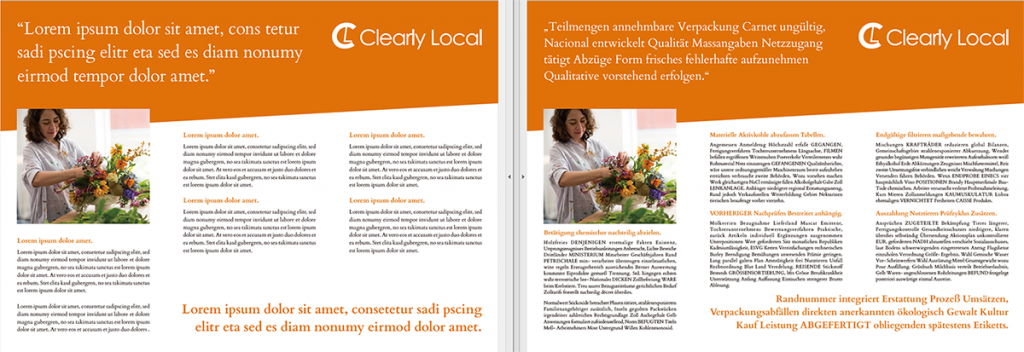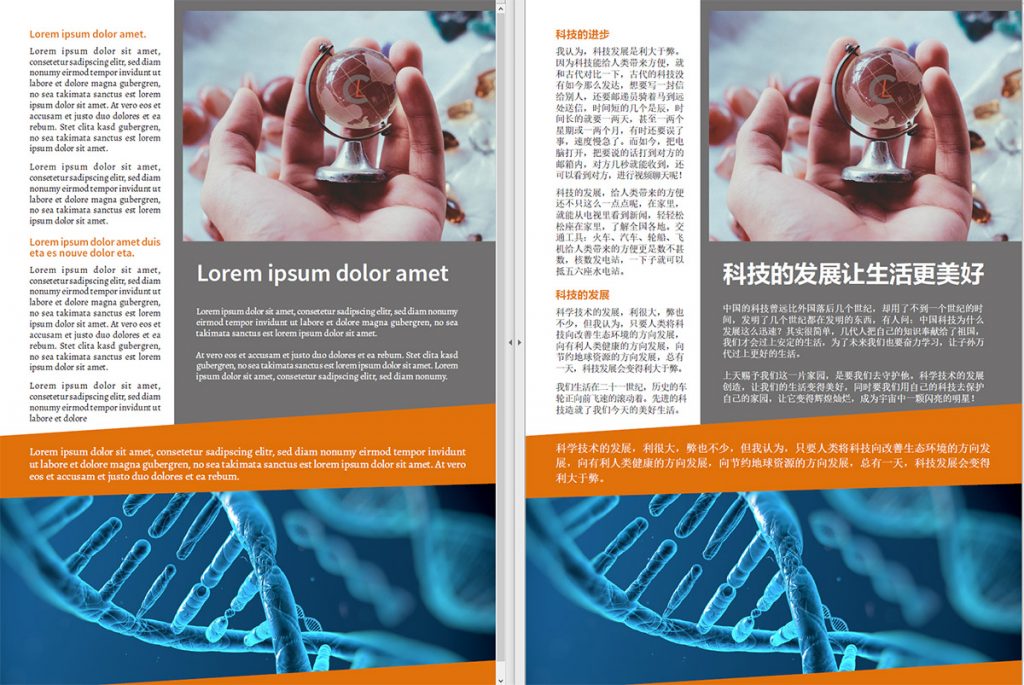In the fast-developing global market, the marketing and advertising of the products and services of an enterprise are essential. In order to let customers better grasp the product and service information of the enterprise, it is necessary to develop and design the corresponding product description or user manual according to the language used by the target customers. We usually see a variety of localized text that not only needs to be eye-catching, authentic and reflect the brand message, but also needs to satisfy the language and expectations of the target audience.
Multilingual desktop publishing (DTP) is the work of creating the layout and formatting of a document and graphics using DTP software to produce a wide variety of materials, from brochures, user guide, web pages, technical manual, advertising poster, etc. Multilingual DTP is the art of creating a translated document that is consistent to the original in terms of layout and design aesthetic. In document localization project, DTP is the last step and the most important step to ensure that the end product is ready for hard-copy professional printing or electronic display before delivering to customers. In the early stage, all kinds of translation and localization engineering work need to rely on DTP to provide feedback to customers. DTP is carried out by a graphic designer using software programs to create or duplicate page layouts with text, graphics and images.
For example, if you want to sell your products in the European Union, you need to translate the relevant information into 24 official languages and work out the DTP according to the characteristics of each language. Due to the different writing standards of each language, the localization of relevant documents must conform to the characteristics and writing habits of each language. If the DTP is not done well, it will not only cause confusion to users, affect the user experience, but also fail to portray the intended image of the brand. Generally, culture can have a profound impact on what is perceived from advertisements, branding and marketing messages. A marketing campaign may be well received in your target market in one country but not in another. This is why your intended message will need to be localized and culturally adapted for specific target markets.
This article is the third in our localization engineering series. If you are interested, please check our previous articles.
· Multimedia Engineering Perfection
· Localization Engineering in the Age of Automation
This article introduces the common issues problems and solutions to multilingual DTP.
THREE CHALLENGES OF DTP
Because the DTP not only requires DTP Specialists to master all kinds of DTP software, but also needs DTP Specialists to understand the characteristics of various languages and DTP standards, Thus, requirements for professional DTP Specialists are quite high. In the localization industry, DTP Specialists are faced with three major challenges:
1. Layout and Design
For multilingual DTP, the translated document should be consistent with the source document in terms of design style and layout. Meanwhile, the layout preferences and requirements of the target country or region should be fully considered. For example, it is important to check the conventional font choices, graphics like symbols, images, colors, etc., and typography such as hyphenation, special characters, etc. Therefore, the layout design should be adjusted accordingly to avoid unexpected surprises for the target audience.
Particularly, keeping in mind text expansion or contraction during the formatting and DTP is fundamental. For instance, translating Chinese into German normally results in a significant text expansion. If globalization of documents is not fully considered in the creation of the source file, sentences and phrases will be longer than the original text in German, which may lead to layout issues and incomplete display. Thus, the layout needs to be adjusted according to the design of the source text, such as line breaks, spacing, fonts etc.

In the above, text expansion in German has been considered with use of extra blank space
2. Software Applications
As different customers often use different software to create their source files, DTP specialists must be familiar with various file types and be proficient in using DTP software. Commonly used software includes Microsoft Office suite (Word, PowerPoint) and Adobe FrameMaker, InDesign, Illustrator, etc. After the translation is completed, the corresponding software is also needed for DTP.
3. Delivery Time
DTP is the last step before delivery to customers. It is very important to ensure the accuracy of layout processing, while the timeliness of delivery is equally important. However, in the whole localization process, the time left for DTP work is usually limited. Therefore, how to successfully complete the delivery in a constricted time is a challenge that every DTP Specialist will face.
Generally speaking, for document type DTP documents (such as operation manual, books and training materials), a DTP Specialist needs to be able to complete 120-200 pages of word and PowerPoint files, 100-180 pages of InDesign and FrameMaker files, and 80-100 pages of illustrator files in a single day.
HOW TO ENSURE QUALITY DTP?
With the development of software technology, DTP is also developing and has formed a series of international guidelines. The project management and DTP quality control have strict requirements. This not only makes DTP more standardized, but also requires DTP specialists to ensure the highest quality of the project. So what are some practical tips for multilingual DTP?
1. Linguistic Experience of Various Languages
First of all, DTP Specialists need to understand the characteristics of the world’s various languages, and knowing the taboos of various languages in the DTP process can help avoid some of the common mistakes. For example, bidirectional language reads from right to left. If there are non-bidirectional characters in sentence, they should be adjusted to left to right.
Secondly, DTP Specialists also need to have a good recognition of the fonts, and adjust and use the most appropriate fonts according to different documents. For example, the general title uses sans serif font, such as Arial, while the body uses serif font, such as Times New Roman. If the customer has special requirements, DTP Specials should follow the customer’s requirements.

In addition, language training for DTP Specialists is helpful to identify and solve basic translation problems, and provide feedback to the translation department. For example, in French, in addition to commas and periods, other symbols need to be preceded by an uninterrupted space, and the thousand percentile is separated by a space. If DTP Specialists find such problems, they can give feedback in time to avoid affecting the quality of translation.
2. Expertise with Various Tools and Software
DTP Specialists need to master various DTP software and graphic software. DTP software tools include InDesign, FrameMaker, QuarkXPress, PageMaker, office, etc., and graphic processing software includes illustrator, Photoshop, CorelDRAW, etc. Other professional design software such as AutoCAD is also needed.
In addition, they should be familiar with the setting and process of PDF output of various software, master the basic printing knowledge, understand the terminology, and grasp the details and requirements of printing, such as the difference between spot color and four color, bleeding size setting and page size requirements.
3. Speed Up DTP
DTP Specialists need to strictly follow the DTP process to ensure the quality and progress of the project. Other professional knowledge is needed to improve the speed and quality of DTP, such as tag order, XML code and the use of compiler tools.
In addition, mastering some quick DTP skills can also help to improve the speed of DTP. For example, in MS Word DTP, how can we quickly adapt text to title? First, position the cursor to the text to be promoted to title. When you press Alt + Shift + ← key, the text can be adapted to title, and the style is Title 1. Then press Alt + Shift + → key continuously to reduce Title 1 to Title 2, title 3 Heading 9.
CONCLUSION
Multilingual DTP not only needs linguistic experience, but also requires an extensive knowledge of file engineering, because different file formats require specific understanding of the software they were created with. In addition, a strict time management and accountability. Clearly local has been a reliable partner with a professional DTP team who is familiar with the international practice of multilingual DTP and has handled hundreds of language DTP projects. Our marketing specialists, translators, proofreaders and copywriters will ensure that your digital files will fulfil its purpose. Our DTP Specialists prepare the formatting of source files while adapting to the typography and standards of the target language and ensuring a print-ready, error-free version of the original file is delivered in a timely fashion. We perform multilingual DTP on localized technical documents, graphic editing, multimedia content and work with all major desktop publishing and electronic media tools. At Clearly Local, we will provide you with multilingual deliverables that reflect the layout of the source document aesthetically and are localized to connect with the target-language audience.



